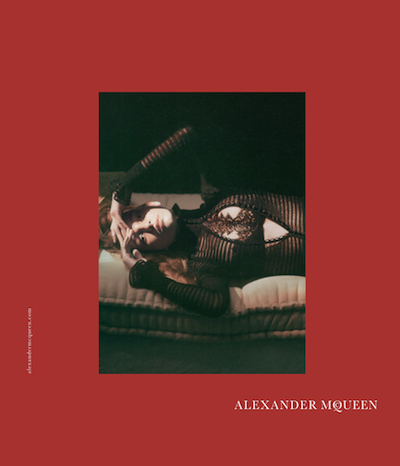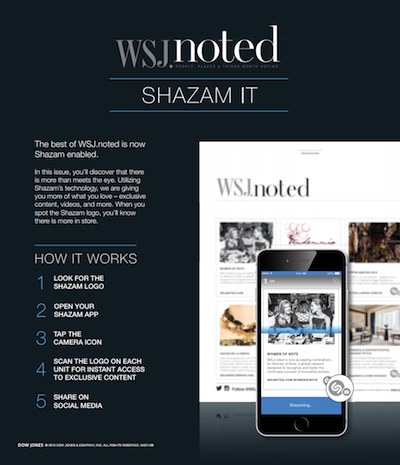WSJ. magazine’s September edition heightens coverage via scannable ads
Bally and Lanvin were among the women’s fashion labels to take part in WSJ. magazine’s September “Women’s Fashion” issue, the publication’s largest book to date.
September sees an influx of fall fashion coverage in nearly every magazine title, making visibility for advertising partners more competitive than usual, but this bout of friendly competition leads to innovation. For September, WSJ. magazine, a “core” read for 4 million fashion-forward, affluent global readers, introduced its partnership with mobile music and video application Visual Shazam to add a progressive layer to annual coverage of the season’s top women’s fashions.
“September always has been, and continues to be, a critical time of year for fashion marketers,” said Anthony Cenname, publisher of WSJ. magazine, New York.
“I’m excited to share that a record-breaking number of advertisers ran in our September Women’s Fashion issue, making it the largest issue ever in our seven-year history,” he said. “By running in WSJ., which has quickly established itself as a core fashion must-read, these marketers reach the most successful and stylish women in over 60 countries worldwide who spend $6.4 billion and fashion, accessories, jewelry and watches annually.”*
September’s WSJ. magazine was inserted in the Aug. 15 edition of The Wall Street Journal.
*Source: 2014 Ipsos Affluent Survey, Total Audience (000); WSJ. Magazine prototype created by DJG Marketing
Progressive reads
The 192-page September issue of WSJ. magazine saw an 11 percent ad page increase from the year-ago edition, with nearly a third of its advertising partners being new to the issue. WSJ. magazine positions its ad partners in front of 1.4 million female readers who spend $6.4 million on apparel, accessories and jewelry annually.
WSJ. magazine’s ad space focused almost entirely on female fashion beginning with a two-page inside front cover spread by Ralph Lauren Collection.

Ralph Lauren on the inside front cover
The front of the book was dominated by the industry’s leading brands such as Chanel, Giorgio Armani, Hermes, Dior, Saint Laurent Paris, Estee Lauder, Dolce & Gabbana, Bottega Veneta and Fendi.
Also seen were campaign efforts placed by Burberry, Harry Winston, Celine, Salvatore Ferragamo, Oscar de la Renta, Max Mara, Moncler, Michael Kors, Balenciaga, Carolina Herrera, Pomellato jewelry, Calvin Klein Collection and Omega watches.

Campaign for Oscar de la Renta
Opposite the table of contents Gucci presented readers with its fall/winter 2015 campaign.
Bulgari also appeared in this section with a full page spread for its Lucea collection in between the content listings. The continued listing was framed by an effort for Prada and Versace handbags.
Within the content well fashion continued to be heavily represented with efforts by Valentino, Stuart Weitzman, Bally, department store chain Bloomingdale’s, Tod’s, Etro, Chloe, Longchamp and Alexander McQueen.
Also seen were campaigns for Kenzo, Saks Fifth Avenue, David Webb jewelry, Loewe, Brunello Cucinelli and Missoni.
The September Women’s Fashion issue concluded with an outside back cover by Louis Vuitton. Here, the brand presented readers with the third installment of its advertising concept titled “Series 3.”

Louis Vuitton on the outside back cover
Content in the issue included a comprehensive look at upcoming fall fashion trends and industry happenings through featured articles on designer Alexander Wang, who recently stepped down from his role as creative director at Balenciaga (see story), Bottega Veneta’s Tomas Maier’s work to save a Tokyo landmark (see story), smaller pieces on Marc Jacobs’ latest scent and Tory Burch’s first foray into activewear and a column from Alber Elbaz of Lanvin on luck.
More than meets the reader’s eye
WSJ. magazine’s September issue also debuted the publication’s partnership with Visual Shazam, an app with 100 million monthly users. The partnership’s aim is to increase interaction between audience and print campaigns using mobile as a catalyst.
To segway its introduction, WSJ. magazine placed an explanatory ad on page 189 of the September issue. Here, those unfamiliar with the app in general or with its visual capabilities can learn the five steps needed to access the exclusive content.
The following page displays 12 luxury brands with scannable content including Bally, Lanvin, Peninsula Hotels, Tod’s, Oscar de la Renta, Pomellato, Ferragamo and Max Mara.
When the image is scanned using Visual Shazam, content is pulled up within the app.
For example, when Lanvin’s winter 2015 campaign is scanned in the WSJ. Noted section, the reader is brought to the brand’s ecommerce Web site, thus making the read come to life by shortening the journey to purchase.

Lanvin’s ecommerce as seen on Visual Shazam
Similarly in 2013, French fashion house Louis Vuitton began layering its print campaigns with a mobile application that brings together exclusive advertising content and mobile commerce.
Louis Vuitton’s Pass app allows consumers to experience ads in new ways with behind-the-scenes content, featured product information and a store locator. The interactive elements of Louis Vuitton’s Pass app engages consumers by curating a personal experience that fleshes out familiar ads (see story).
“This month we debut our progressive partnership with Shazam, having offered its new visual recognition capabilities to 12 luxury advertisers who bring their print campaigns to life on the mobile devices of WSJ.’s readers, readers who spend 134 percent more time on social media per month than the average affluent consumer,” Mr. Cenname said.*
“We felt it was important to provide our marketing partners with a unique added value offer as they launch their fall campaigns,” he said. “To do this, we provided an upscale, promotional environment within our WSJ. Noted pages that allowed these 12 brands’ vibrant print campaigns – each marked with the Shazam logo – to harmoniously coexist.
“At the end of the day, advertising is about engaging consumers and driving them to take action. Adding Shazam-enablement to a brand’s campaign transports WSJ.’s readers from the magazine’s pages directly to the digital experience of the marketer’s choice.”
*Source: 2014 Ipsos Affluent Study.
Final Take
Jen King, lead reporter on Luxury Daily, New York


